Archaeoastronomy of the Ocmulgee Earth Lodge
Was the Ocmulgee earth lodge an astronomical observatory and sophisticated scientific apparatus designed to forewarn its designers of impending catastrophe coming from the heavens?
Introduction
The earth lodge at the Ocmulgee Mounds site in Macon, Georgia is a unique building among Native American archaeological sites in the Southeast. It is a round building completely covered with earth except for a smoke hole in the center of the roof to allow smoke to escape from the central fire pit below. Entry into the earth lodge was from the east through a low, long, tunnel-like, earth-covered corridor. One would have to crouch or crawl until he reached the central, round chamber before he could stand fully erect again. According to the Creek Migration Legend this structure was where the tribe’s warriors would gather “to fast and purify their bodies,”[1] thus entry was likely limited to males exclusively.
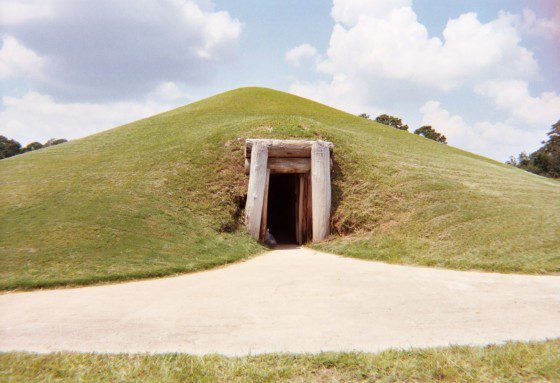
The main chamber was bounded by a low wall upon which rested the lower ends of the roof timbers. There were four large upright posts in the middle of this circular chamber that supported four horizontal posts that formed a large square. The middle of the roof timbers rested on these horizontal timbers and on top of these timbers earth was piled thereby creating the earth-covered roof of this structure. The roof timbers did not all meet in the center instead leaving a large hole through which smoke could escape.
In the center of the floor between these four upright posts was a large fire pit molded into the clay floor. Along the floor against the circular low wall were a series of 47 seats molded into the clay floor. Each had a small cubbyhole molded into the front of the seat, the exact purpose of which is unknown although it was likely a place to store personal items.
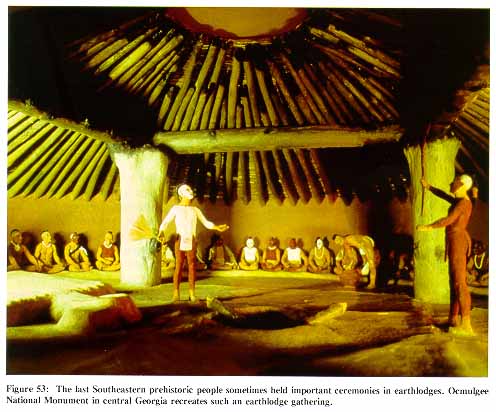
On the western end of this round chamber was a large, elevated platform or altar in the shape of a bird. The bird likely represented a raptor, either an eagle or falcon, both highly revered among Creek Indians. Surrounding the eye of the raptor was a design known as the ‘forked eye motif.’ It had the appearance of a two-tailed comet. (More on this later.) This is the earliest known instance of this symbol, which eventually became widespread throughout much of Southeastern and Midwestern America. One researcher noted that mythological beings represented with the forked-eye surround were associated with the celestial realm[2]which is consistent with a comet interpretation. Finally, three more seats were located on this platform bringing the total number of seats in this great chamber to fifty. Clearly these three elevated seats were reserved for very important persons.
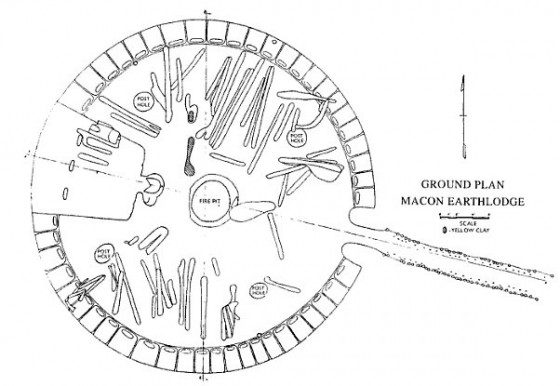
The only artifact excavated from the interior of the chamber was a large conch shell. These shells were reserved for serving a ritual tea known as both the “black drink” because of its color and the “white drink” because of its use in purification rituals. The tea was made from the leaves of the yaupon holly plant. The leaves of this plant had high concentrations of caffeine, many times more than a similar amount of coffee, and was drunk piping hot thus increasing the absorption of caffeine into the bloodstream.
Origins of the Ocmulgee Earth Lodge
Creek Indian tradition maintains that the Ocmulgee Mounds site in Macon, Georgia was the site where they “first sat down” after their long migration from the west.[3] One version of the Creek Migration Legend states that one of the first structures the tribe built when they arrived at their final destination in the east was a “mound [with a] great chamber in the center.”[4]
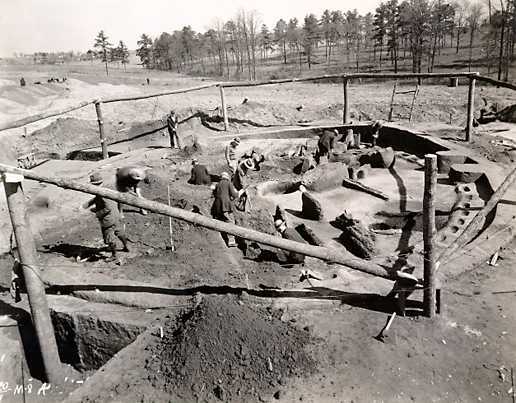 The earth lodge was unearthed at Ocmulgee Mounds during excavations in 1938.[5] The earth lodge had been burned and archaeologists were able to date this charcoal to around 1015 AD[6]. Whether the structure was burned by its own inhabitants or by an attacking enemy is unknown.What is known is that the structure is unique in the Southeast. Archaeologist Lewis Larson noted that the 19th century researcher Swanton
The earth lodge was unearthed at Ocmulgee Mounds during excavations in 1938.[5] The earth lodge had been burned and archaeologists were able to date this charcoal to around 1015 AD[6]. Whether the structure was burned by its own inhabitants or by an attacking enemy is unknown.What is known is that the structure is unique in the Southeast. Archaeologist Lewis Larson noted that the 19th century researcher Swanton“provided the most detailed and exhaustive survey of the ethnohistorical literature covering the domestic and public architecture of the southeastern Indians. A review of his survey reveals that there are no structures comparable to the Macon Plateau earth lodge as it has been described by Kelly….”[7]
This very uniqueness caused Larson to call into question Kelly’s “earth lodge” interpretation of his findings and Larson even went so far as to refute the very existence of earth lodges in the Southeast even at Ocmulgee Mounds. Yet the migration legend seems to support Kelly’s interpretation of the data as, indeed, a “mound with a central chamber,” i.e., earth lodge.
Archaeaoastronomy of the Ocmulgee Earth Lodge
The Pawnee were a Midwestern Caddoan tribe that also constructed earth lodges similar to the one at Ocmulgee Mounds. Some of these earth lodges were used as astronomical observatories.[8]The Pawnee earth lodge observatories had entranceways facing east just like Ocmulgee’s earth lodge. They also had an altar on the western end of the interior chamber just like Ocmulgee’s earth lodge except the Pawnee altars were not bird-shaped. (Although lots of bird remains including a bluejay, owls, woodpeckers, eagles, quails and others were found in some Pawnee earth lodge observatories suggesting birds were an important part of the activities that took place inside.)
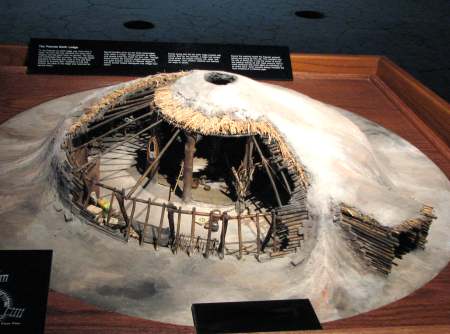 |
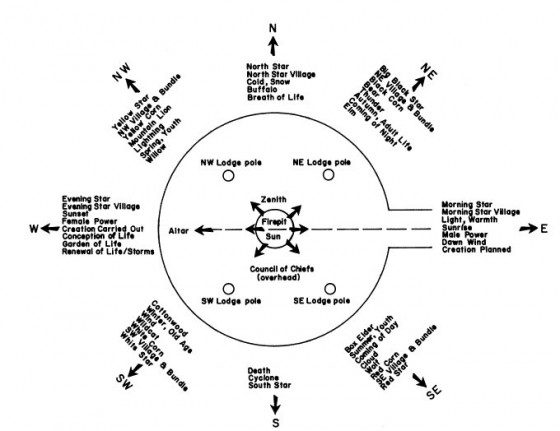 |
| Model of Pawnee earth lodge | Layout of Pawnee earth lodge |
Researchers have listed five characteristics of Pawnee earth lodges that indicated they had been used as a priestly observatory:
- unobstructed view of the eastern sky
- east-west orientation so that at the vernal equinox the sun’s first light would strike the altar
- the size parameters of the lodge’s smoke hole and door (height and width) would be designed to view the sky
- the lodge’s smoke hole would be constructed to view certain parts of the heavens-such as the Pleiades
- the presence of four main interior support posts correctly aligned to the semicardinal points.
How well does the Ocmulgee earth lodge match up with these five conditions? The Ocmulgee earth lodge was constructed on top of a bluff or plateau thus it would have had an unobstructed view of the eastern sky. It also had four main interior support posts aligned to the semicardinal directions. The structure also had an east-west orientation yet, according to researchers, its doorway aligned to the sunrise on February 22nd and October 22nd instead of the vernal equinox (March 21.) (Using software called The Photographer’s Ephemeris I was able to confirm this alignment.)
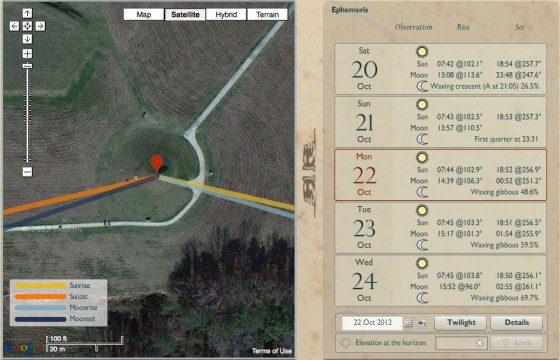 |
|
This satellite image shows the door of the earth lodge perfectly aligned with the sunrise (yellow line) on October 22. ©The Photographer’s Ephemeris & Google Maps. |
Why would the builders have chosen this date instead of the vernal equinox? Was there any significant astronomical event on this day that they may have wanted to mark? In our current era, October 22nd represents the peak night of the Orionid meteor shower. Yet 1,000 years ago, due to precession of the equinoxes, the Orionids would have peaked 14 days earlier on October 8th. The Taurid meteor shower, however, which today peaks on November 5th, would have also peaked 14 days earlier at that time; i.e., on October 22nd.
The Taurids were created by debris left over from comet Encke. This shower, which produces spectacular fireballs, appears to originate from the Pleiades asterism within the constellation Taurus. As noted previously, a bird-shaped platform or altar was located at the western end of the Ocmulgee earth lodge. This bird had a design around its eye known as the ‘forked eye motif’ that was in the shape of a two-tailed comet.[9]Thus 1000 years ago on October 22, sunlight would have streamed through the Ocmulgee earth lodge’s doorway and landed on the bird platform with the comet-like forked-eye design. That night the peak activity of the Taurid meteor shower would have occurred.
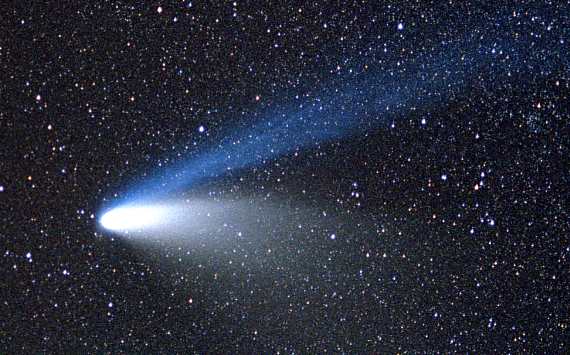 |
| Comet Hale-Bopp’s two tails reminiscent of the ‘forked-eye motif’ |
Additionally, using the software program Stellarium, I was able to determine that the Pleiades were very high in the sky just past midnight on October 22, 1015 AD and therefore visible through the smoke hole of the Ocmulgee earth lodge. Thus the very constellation from which the Taurid meteor shower originated would have been visible directly overhead through the smoke hole.
Therefore, the Ocmulgee earth lodge meets all five criteria indicative of its use as a priestly observatory except it was aligned with a significant astronomical event other than the vernal equinox.
Doomsday Clock?
Curiously, around the same time that archaeologists have dated the destruction of the Ocmulgee earth lodge by fire, a cosmic catastrophe seems to have impacted Earth, likely the result of the Taurid meteor shower. According to the Anglo Saxon Chronicle, on September 28, 1014 AD, a tsunami devastated many towns in England.[10] (In our modern Gregorian calendar this date would equate to October 4, 1014 AD.)[11] Researchers in North Carolina have noted that either a major storm surge or tsunami devastated the coastal areas of the state around this time as well.[12] Considering all the evidence for a major Atlantic tsunami at this time it was most likely this tsunami not storm surge that devastated coastal North Carolina.[13]
Dallas Abbott of the Lamont Doherty Observatory at Columbia University found tsunami deposits from the same time period in New York, the Caribbean and northern South America.[14] She also found sediment deposits from the mid-Atlantic ridge in an inland bog in New York that also dated to the same time period. Her research concluded that the only thing that could have produced all these effects was a meteor impact in the center of the Atlantic Ocean. Abbott noted that all these events corresponded with a large ammonium spike in the Greenland ice core record similar to other such spikes recorded around the time of known meteor impacts.
Other researchers going back through the historical record found that the 11th century featured one of the most active Taurid meteor showers ever recorded. I. S. Astapovich and A. K. Terent’eva conducted a study of fireballs appearing between the 1st and 15th centuries and revealed the Taurids to have been “the most powerful shower of the year in the 11th century (with 42 fireballs belonging to them) and no shower, not even the great ones, could be compared with them as to activity.”[15]Thus the Taurid meteor storm of 1014 must have been truly an awe- inspiring spectacle even greater than the Leonid meteor storm of 1833.
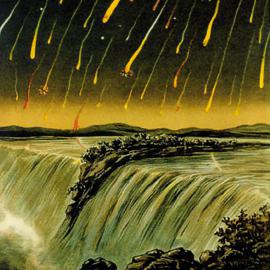 |
| Leonid meteor shower of 1833 as seen at Niagara Falls |
Thus all the evidence supports the theory that a meteor slammed into the middle of the Atlantic and produced tsunamis that impacted coasts on both sides of this ocean in the Fall of 1014 AD.
Coincidentally, according to Aztec legend, their Fourth Sun ended in 1011 AD due to a great flood followed by the sky falling. This event is recorded on the Aztec Calendar Stone or Stone of the Fifth Sun that included two xihucoatls, “fire serpents,” around the outside edge of the sculpture. Each “fire serpent” had a snout with seven star symbols that represented the seven stars of the Pleiades.[16] This suggests these “fire serpents” were flaming meteors emanating from the Pleiades and thus were part of the Taurid meteor stream. The Taurids are known for slow-moving fireballs with long smoke trails thus the designation of “fire serpent” is quite appropriate. The fact that the Fourth Sun ended with a flood is consistent with these “fire serpents” having impacted the ocean creating a tsunami. Yet their date of 1011 AD is two years off from the known impact date of 1014 AD. Why?

Researchers have noted that after the Aztecs won their independence in 1428 they revised many historical events to fall on important dates within their 52 year calendar cycle called the xiuhmolpilli.[17] One researcher noted, “A number of events of early history were assigned to dates with important positions in the 52-year cycle and that certain types of events were recorded as occurring in years of the same name.”[18]Additionally, astronomer Anthony Aveni noted that “calendrical adjustments were frequently geared to the 52-year xiuhmolpilli or one [of] its multiples….”[19]Thus this could explain why the flood that ended the Aztec’s Fourth Sun and resulted in the creation of the Fifth Sun is said to have taken place in 13 Reed, 1011 AD, instead of the actual date of 1014 AD.
The Taurids are active from early October until late November in modern times and a thousand years ago would have ranged from late September until mid November. Thus the date recorded in the Anglo-Saxon Chronicle, September 28, 1014 (October 4, 1014 AD in our modern Gregorian calendar), is consistent with an interpretation that two large meteors (fire serpents) part of the Taurid meteor stream crashed into the middle of the Atlantic Ocean and caused tsunamis that spread out and impacted shores all around its perimeter.
Is this the reason the people at Ocmulgee burned their observatory sometime around 1015 AD (perhaps even in 1014 AD)? Was the Ocmulgee earth lodge a place where the men of Ocmulgee cleansed and purified themselves through various rituals all with the hopes of appeasing their gods and avoiding future catastrophes?
When these purification rituals failed to prevent another catastrophe did they burn the observatory to the ground out of frustration? Or did they believe that such catastrophes could only occur at the peak of Taurid meteor shower activity on October 22nd and when it came earlier on October 4th they realized their doomsday predictor, the earth lodge with its perfect alignments, had failed and was no longer of any use?
This type of ritualized behavior was quite common among the indigenous people of North America. For instance, the Aztec Calendar Stone was associated with the New Fire Ceremony and this ceremony, in turn, was associated with the Pleiades. The New Fire Ceremony was conducted every 52 years when the Aztec’s two primary calendars came back into sync. They called this event the “binding of years” and the New Fire ceremony marked the occasion.
The last New Fire ceremony took place in 1507 at the temple of Huixachtlan on the top of Huixachtecatl, “Hill of the Star.” The “star” in question was the Pleiades asterism. According to the Franciscan missionary Bernardino de Sahagun who wrote a 12 volume history of Mexico the New Fire ceremony went something like this:
…they considered it a matter of belief that the world would come to an end at the conclusion of one of these bundles of years. They had a prophecy or oracle that at that time the movement of the heavens would cease, and they took as a sign [of this] the movement of the Pleiades. On the night of this feast, which they called Toximmolpilia [the Binding of the Years***] it so befell that the Pleiades were at the zenith at midnight with respect to the horizon in Mexico. On this night they made new fire, and before they made it, they extinguished all the fires in all the provinces, towns and houses in all of this New Spain. And they went in a solemn procession. All of the priests and servants of the temple departed from here, the Temple of Mexico, during the first quarter of the night, and went to the summit of that mountain near Itztpalapan which they call Uixachtecatl. They reached the summit at midnight, or almost, where stood a great pyramid built for that ceremony. Having reached there, they looked at the Pleiades to see if they were at the zenith, and if they were not, they waited until they were. And when they saw that now they passed the zenith, they knew the movement of the heavens had not ceased, and that the end of the world was not then. [Vol. 4, p143]
And when they drew the new fire, they drew it there at Uixachtlan, at midnight, when the night divided in half, They drew it upon the breast of a captive, and it was a well-born one on whose breast [the priest] bored the fire drill. And when a little [fire] fell, when it took flame, then speedily [the priest] slashed open the breast of the captive, seized his heart, and quickly cast it there into the fire. [Vol. 7, p25]
Then [the priests] slashed open [the captive’s] breast. In his breast [cavity] the new fire was drawn. They opened the breast of the captive with a flint knife called ixcuauac. [Vol. 7, p28]
These New Fire rituals were dedicated to the god Huitzilopochtli.[20] Curiously he was associated with birds and birds were given to him as offerings, primarily hawks and quail. This is reminiscent of the bird offerings found in Pawnee earth lodges as well as the bird platform thought to represent a hawk or eagle in the Ocmulgee earth lodge.
Other ceremonies dedicated to this god also appear to reenact a meteor impact event. For instance, Sahagun’s description of the annual Panquetzalitztli festivals, held in honor of Huitzlilopochtli, notes:
“in a concluding episode of the ritual events, a large paper-and-feather xihucoatl [fire serpent] was brought down the steps from the platform of the Main Pyramid, to be presented at an altar on the bottom landing: Thereupon likewise descended the fire serpent, looking like a blazing pine firebrand. Its tongue was made of red arara feathers, looking like a flaming torch. And its tail was of paper, two or three fathoms long. As it descended, it came moving its tongue, like that of a real serpent, darting in and out. And when [the priest] had come [with it], bringing it down to the base [of the pyramid], he proceeded carefully to the eagle vessel. Then he went up [to the eagle vessel] and raised [the fire serpent] also to the four directions. When he had [so] raised it up, then he cast it upon the sacrificial paper, and then they burned. (Sahagun 1951-70, Bk. 2:136).”[21]
A fire serpent descending from the heavens (i.e., top of the pyramid) and bursting into flames once reaching Earth is the perfect metaphor for a meteor impact.
Celestial Origins of the Forked-Eye Motif
In order to test a hypothesis, one must be able to make predictions and then verify those predictions with research data. Thus if the forked-eye surround is truly a representation of a comet or comet fragment (i.e., meteor) then other creatures that wear this design should also have associations consistent with this interpretation. In fact, they do.

The forked-eye surround would later be found on another creature associated with the sky: the horned feathered serpent. Among the Cherokee this creature was known as Uktena and its description is consistent with a comet or meteor:
Those who know say the Uktena is a great snake…with horns on its head, and a bright blazing crest like a diamond on its forehead, and scales glowing like sparks of fire. It has rings or spots of color along its whole length, and cannot be wounded except by shooting in the seventh spot from the head, because under this spot are its heart and its life. The blazing diamond is called Ulun’suti—”Transparent”—…for whoever is seen by the Uktena is so dazed by the bright light that he runs toward the snake instead of trying to escape. As if this were not enough, the breath of the Uktena is so pestilential, that no living creature can survive should they inhale the tiniest bit of the foul air expelled by the Uktena.[22]
The fact that the myth includes reference to seven spots may associate this creature with the Pleiades in the constellation Taurus. The fact that this creature is also antlered likely also associates it with the constellation Taurus, the only constellation that looks like a horned animal. There are accounts of meteorite impacts releasing noxious gases that have sickened people,[23] which is also consistent with the Cherokee legend. Among the Lakota Sioux the Unktehi caused a great flood[24]which is consistent with other evidence presented earlier.
Conclusions
The Ocmulgee earth lodge was an astronomical observatory for the observation of the Taurid meteor shower. The fact that the door of this observatory was aligned with the peak activity of this meteor shower supports this hypothesis. Evidence is suggestive that the forked-eye surround motif on the bird platform is associated with celestial phenomena such as comets or meteors and thus supports the hypothesis. The fact that the Taurid meteor shower experienced an elevated level of activity during the 11th century likely inspired the creation of the Ocmulgee earth lodge observatory. The fact that this observatory’s destruction coincided with an oceanic impact event and associated tsunami likely caused by meteor(s) from the Taurid complex was no accident and was a purposeful response to this catastrophic event.
References Cited
[1] Grantham, Bill. Creation Myths and Legends of the Creek Indians. University Press of Florida, 2002: pp. 149.
[2] Townsend, Richard. Hero, Hawk, and Open Hand. p.130 Accessed online 18 July 2012 at < http://books.google.com/books?id=zomCBhVLLGcC&lpg=PA130&ots=-vRdD1Aoo2&dq=celestial%20origin%20of%20forked%20eye&pg=PA130#v=onepage&q=celestial%20forked%20eye&f=false>.
[3] Fairbanks, Charles H. Archeology of the Funeral Mound. University of Alabama Press: 2003, p. 6.
[4] Grantham, Bill. Creation Myths and Legends of the Creek Indians. University Press of Florida, 2002: pp. 149.
[5] Larson, Lewis. “The Case for Earth Lodges in the Southeast.” Ocmulgee Archaeology, 1936-1986. University of Georgia Press, 1994: p.105
[6] Historic Structure Report The Earth Lodge Ocmulgee National Monument. National Park Service, 2004: p. 1. Accessed online 18 July 2012 at <http:// www.nps.gov/history/history/online_books/ocmu/ocmu_earthlodge_hsr.pdf>.
[7] Larson, Lewis. “The Case for Earth Lodges in the Southeast.” Ocmulgee Archaeology, 1936-1986. University of Georgia Press, 1994: p.108
[8] O’Brien, Patricia J. “Prehistoric evidence of Pawnee Cosmology”, American Anthropologist (New Series) Vol. 88, No. 4 (Dec 1986), pp 939–946.
[9] Daniels, Gary C. “Ocmulgee Mounds.” LostWorlds.org, 2004: https://lostworlds.org/ocmulgee_mounds
[10] Ingram, James (trans). “Anglo-Saxon Chronicles.” Accessed online 24 November 2010 at <http://classiclit.about.com/library/bl-etexts/anon/bl-anon-anglo-saxon-3.htm>.
[11] Walker, John. Calendar Converter. Accessed online 17 July 2012 at < http://www.fourmilab.ch/documents/calendar/>.
[12] Culver, Stephen J, et al. “Late Holocene Barrier Island Collapse: Outer Banks, North Carolina, USA.” The Sedimentary Record. Society for Sedementary Geology, December 2007: pp. 4-8. Accessed online 18 July 2012 at < http://www.scribd.com/doc/77171096/North-Carolina-Tsunami>.
[13] Howard, George. “Hurricane or Tsunami?: North Carolina coast turns to Tar Hell around time of Magna Carta.” CosmicTusk.com. Accessed online 17 July 2012 at < http://cosmictusk.com/hurricane-or-tsunami-north-carolina-coast-turns-to-tar-hell-around-time-of-battle-of-hastings/>.
[14] Abbott, Dallas. “Exotic Grains in a core from Cornwall, NY- Do They Have an Impact Source?” Journal of Siberian Federal University. Accessed online November 25, 2010 at <http://elib.sfu-kras.ru/bitstream/2311/1632/1/01_.pdf>.
[15] Astapovi?, I. S., and Terenteva, A. K. In Physics and Dynamics of Meteors. Kresák, L., and Millman, P. M (Eds.). IAU Symposium 33. Reidel, Dordrecht.
[16] Jenkins, John Major. Maya Cosmogenesis 2012. 1968. p. 308.
[17] Aveni, Anthony. “Astronomical considerations in the Aztec expression of history: Eclipse data.” Ancient Mesoamerica, 10 (1999), 87-98. Accessed online 26 Nov 2010 at <http://www.mexicauprising.net/aztececlipsedata.pdf>.
[18] Umberger, Emily. “The Structure of Aztec History.” Archaeoastronomy, The Bulletin of the Center for Archaeoastronomy IV (1981):10-18.
[19] Aveni, Anthony. “Astronomical considerations in the aztec expression of history: Eclipse data.” Ancient Mesoamerica, 10 (1999), 87-98. Accessed online 26 Nov 2010 at <http://www.mexicauprising.net/aztececlipsedata.pdf>.
[20] “Huitzilopochtli.” Wikipedia.org. Accessed online 18 July 2012 at <http://en.wikipedia.org/wiki/Huitzilopochtli>.
[21] Townsend, Richard F. State and Cosmos in the Art of Tenochtitlan. p.70 Accessed online 26 Nov 2010 at <http://books.google.com/books?id=Xn-lIHpVG7oC&lpg=PP1&ots=TbZDDrTW11&dq=richard%20f.%20townsend&pg=PA70#v=onepage&q&f=false>.
[22] Mooney, James. Myths of the Cherokee. US Bureau of American Ethnology, 1897-8 Annual Report, 1902.
[23] Orozco, Jose. “Meteor Crash in Peru Caused Mysterious Illness.” National Geographic News. September 21, 2007. Accessed online 18 July 2012 at <http://news.nationalgeographic.com/news/2007/09/070921-meteor-peru.html>.
[24] “LAKOTA CREATION MYTH.” IndianLegend.com. Accessed online 18 July 2012 at <http://www.indianlegend.com/lakota/lakota_001.htm>.

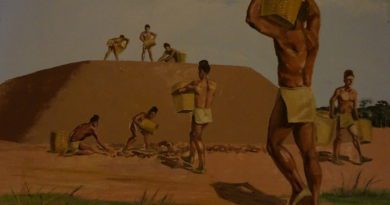

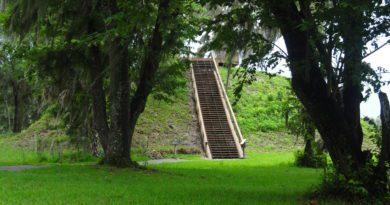
Pingback: Museum of Mysteries » The earth lodge at the Ocmulgee Mounds
Pingback: A Light on Fort Mountain… | Real Spooks